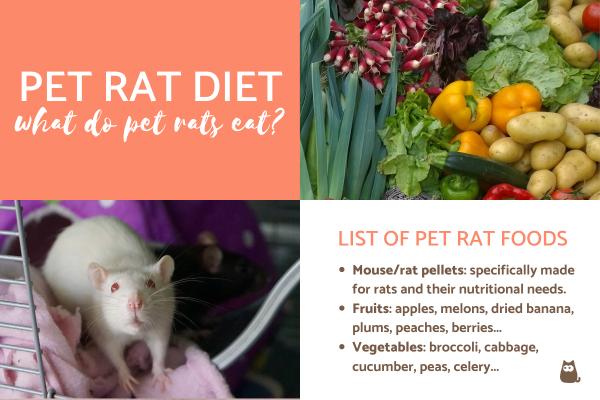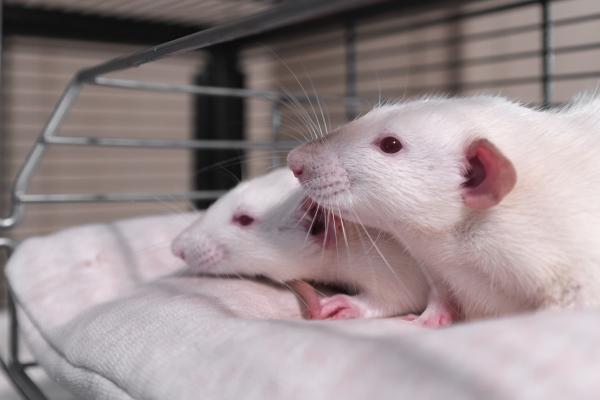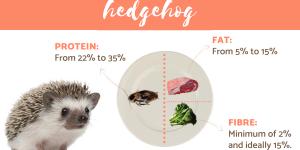What Can I Feed My Pet Rat?


Are you thinking of adopting a pet rat? These rodents are intelligent, affectionate, charming and playful, making them the perfect companion pet. When adopting a pet rat we need to understand how to care for them. One of the most important aspects of their care is the proper rat diet.
In this AnimalWised article we're going to explain what to feed your pet rat. We'll go through their nutrition needs and give you a list of foods that you can feed your pet rat so they are healthy and happy!
Rats as a pet
Before knowing what rats eat, it is very important to know how to differentiate these small mammals from other domestic rodents such as hamsters. This is because although they have a similar appearance and diet, they are completely different species. Here are some general characteristics of rats:
- Rats are generally slender with a pointed head, large eyes, and prominent, thinly furred ears.
- They have moderately long legs and long, sharp claws.
- The bald soles of their narrow hind feet possess fleshy pads of variable size, depending on species.
- Domestic rats live an average of 2-3 years.
You may also be interested in our article on the difference between mice and rats.
Rat digestive system
Now, focusing on the digestive system of mice, which is what will allow us to know what they eat, we can say that they are mainly herbivores, so their digestive system is adapted to consume plant matter. However, today they can be considered omnivorous animals since in the wild they will occasionally feed on insects.
After food is eaten, it is broken down and digested by the rat's stomach and digestive system. Vegetable matter is degraded in the cecum, but it does not absorb the resulting proteins and vitamins. Lastly, the waste is expelled through the anus.
Rat teeth
On the other hand, it is important to note that their incisor teeth grow continuously, so they must be filed through food intake or through chewing. If your rat cannot wear down these teeth, they can develop pain and mouth problems that will prevent the animal from eating and, therefore, can die from extreme physical weakness.
To avoid this, we will need to provide our pet rat with safe elements for them to chew and gnaw, such as:
- Cardboard
- Coconut shells
- Hay cubes
- Unbleached loofah
- Pumice stone
- Seagrass

What wild field rats eat
These small animals have a very high metabolism, so they consume food several times a day. Newborn rats are fed breast milk for the first 20-25 days of their life. After weaning, baby rats will begin eating their mainly herbivorous diet. Wild field rats eat:
- Plants
- Fruit
- Seeds
- Vegetables
- Human food remains
- Insects
Learn more about wild rats in our article about what wild rats eat.
What domestic pet rats eat
What do pet rats eat? Pet rats eat a mainly plant-based diet with a variety of fruits and vegetables. Many rat caregivers will also provide their pet rat with mouse/ rat pellets. These are great as they are specifically made to provide a rat with their nutritional needs. In summery, a pet rat diet consists of:
- Mouse/rat pellets: specifically made for rats and their nutritional needs.
- Fruits: apples, melons, dried banana, plums, peaches, berries...
- Vegetables: broccoli, cabbage, cucumber, peas, celery...
Continue reading to know the complete list of safe food for rats and toxic food for rats.
How much does a rat eat in a day?
Rats will eat between 12 to 20g of dry mix a day. However, if you feed them lots of protein and carbohydrates, you will need to reduce this amount. Vegetables can be fed freely as they have low calories and provide great nutritional value for your pet rat.
Since rats are very small animals, it's best to feed them small amounts of food several times a day. For better guidelines, be sure to ask the adoption centre or breeder you get your rat from. This is because there are many different types of domestic rats, some smaller than others. Also, if your rat is pregnant, nursing, or still growing, their food intake needs will likely increase.
In regards to their nutrition, rats generally need their diet to be about 75- 80% carbohydrates, 12 - 20 % protein and around 4 - 6% of fat. Keep in mind that too much protein can cause your rat to itch, causing scabs.

Safe pet rat food list
Although rats eat a grand variety of fruits and vegetables, there are certain foods that are toxic to them. To avoid feeding our pet rat toxic food, let's take a look at what fruits and vegetables are safe for rats to eat:
Vegetables
- Carrot
- Broccoli
- Cabbage
- Cauliflower
- Chicory
- Sweet peppers
- Cucumber
- Cress
- Courgette
- Peas
Fruit
- Apple (make sure you remove the seeds first)
- Pear
- Peach
- Melon
- Dried banana
- Red grapes
Herbs
- Basil
- Sage
- Parsley
- Coriander
Toxic food for rats list
Now that we've seen what food is safe for rats, it's time to see what foods are not safe for rats to eat. The following list is foods that are toxic for rats:
- Citrus fruits like oranges, lemons or grapefruit
- Blue cheese
- Green bananas as it inhibits starch-digesting enzymes
- Green potato skin
- Licorice as it is suspected to cause neurological poisoning in rats
- Mango
- Raw artichokes
- Raw dry beans or peanuts
- Raw red cabbage
- Raw brussel sprouts
- Raw sweet potato
- Avocado
- Rhubarb
- Sticky foods such as peanut butter, some candy, and dried fruits – poses a choking hazard
- Seaweed
- Any processed human food, such as cookies, chocolate, sugary treats, etc.

If you want to read similar articles to What Can I Feed My Pet Rat?, we recommend you visit our Healthy diets category.
- Exposito Ocaña LM (2015). Anatomy and physiology of rodents and domestic or pet lagomorphs . Diseases., From Paradais Sphynx. Website: https://mamiferos.paradais-sphynx.com/informacion/anatomia-fisiologia-roedores-lagomorfos-mascotas.ht







